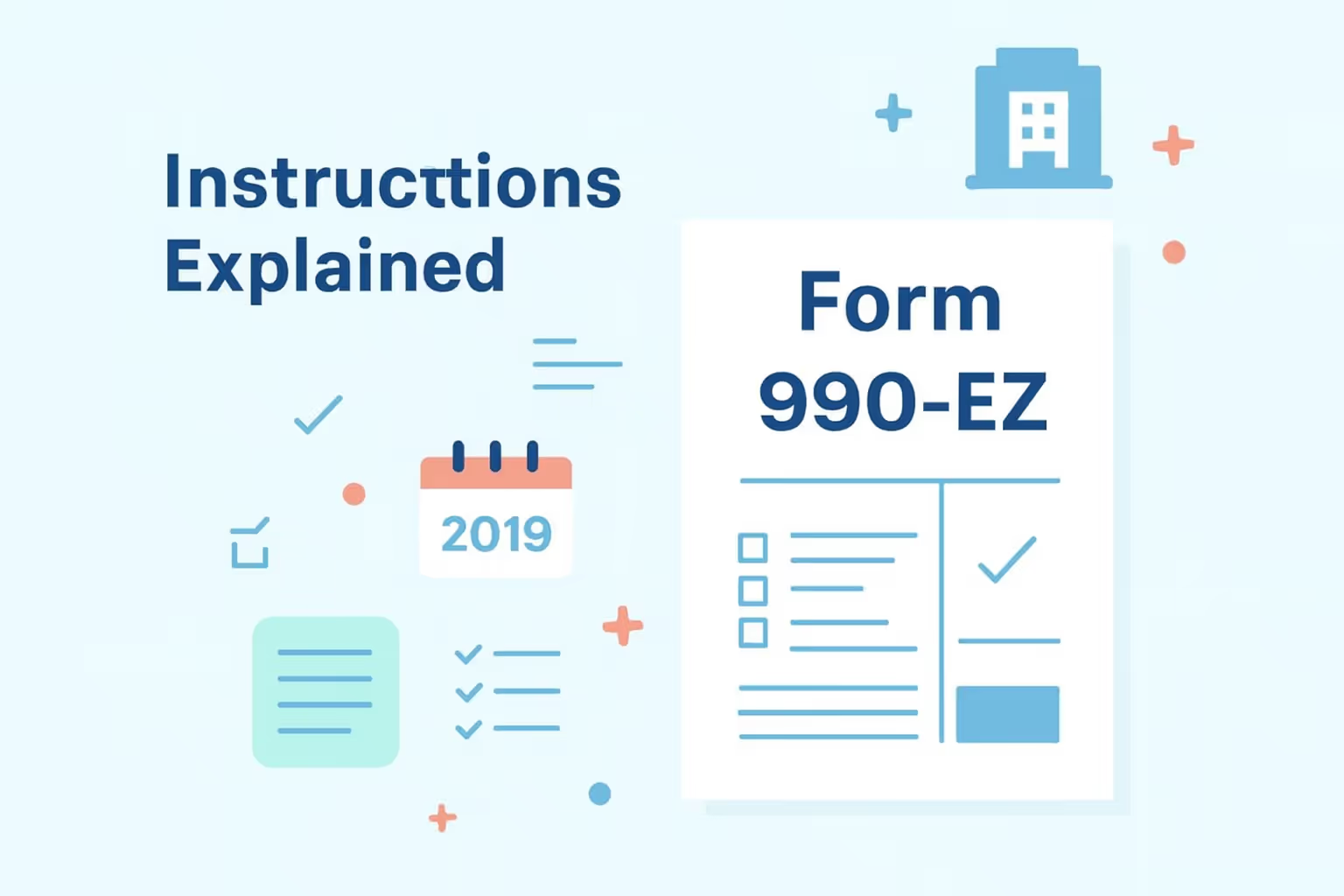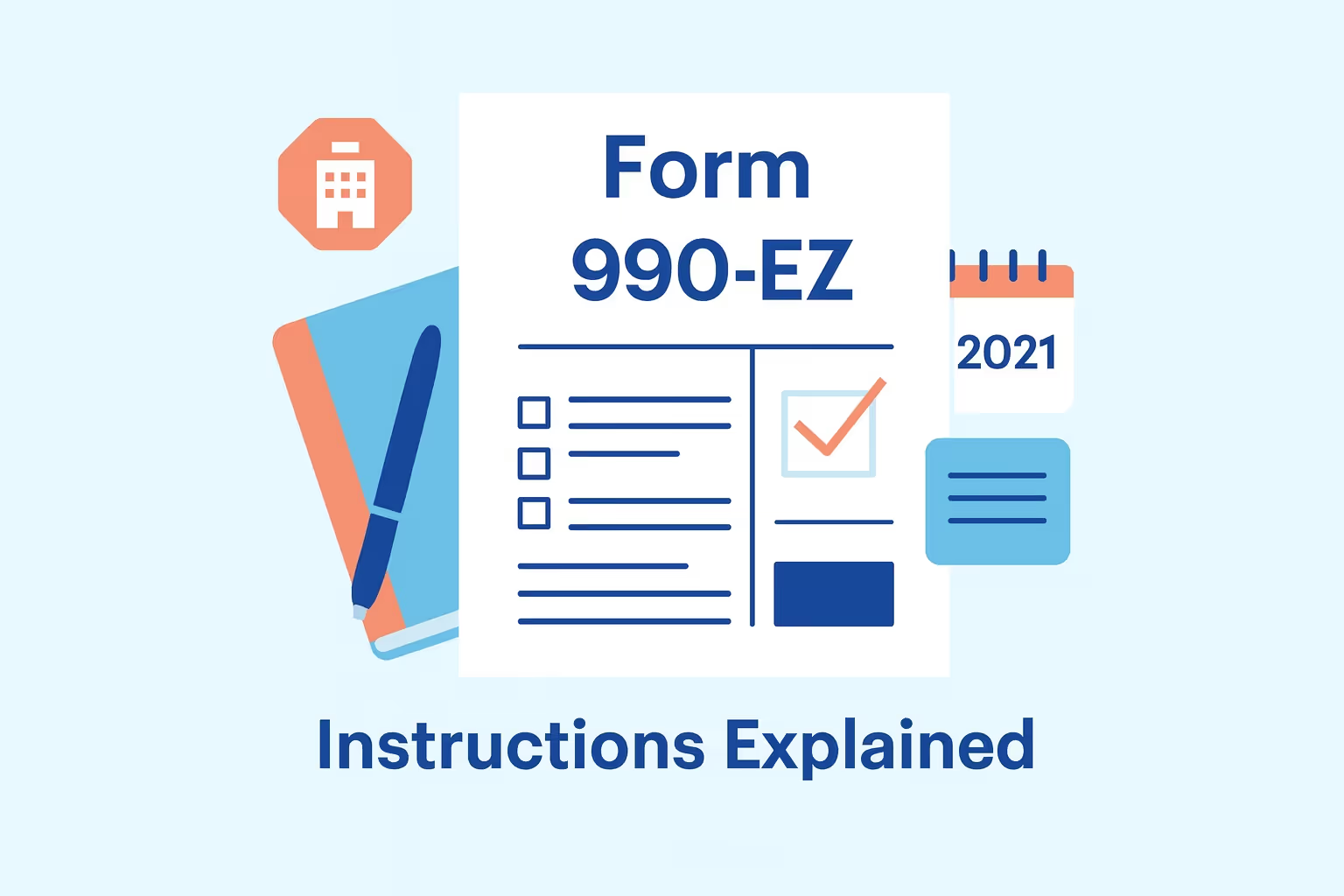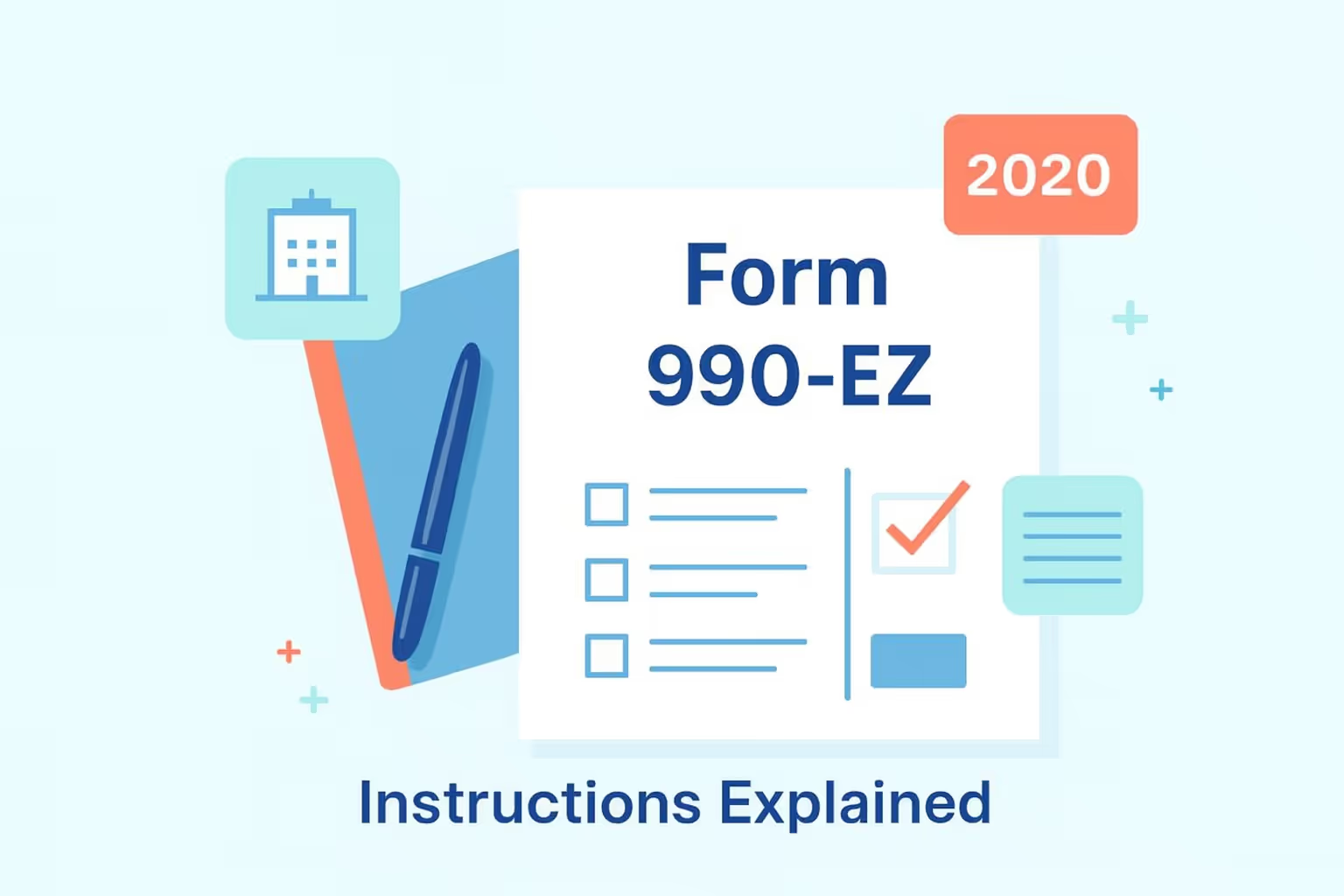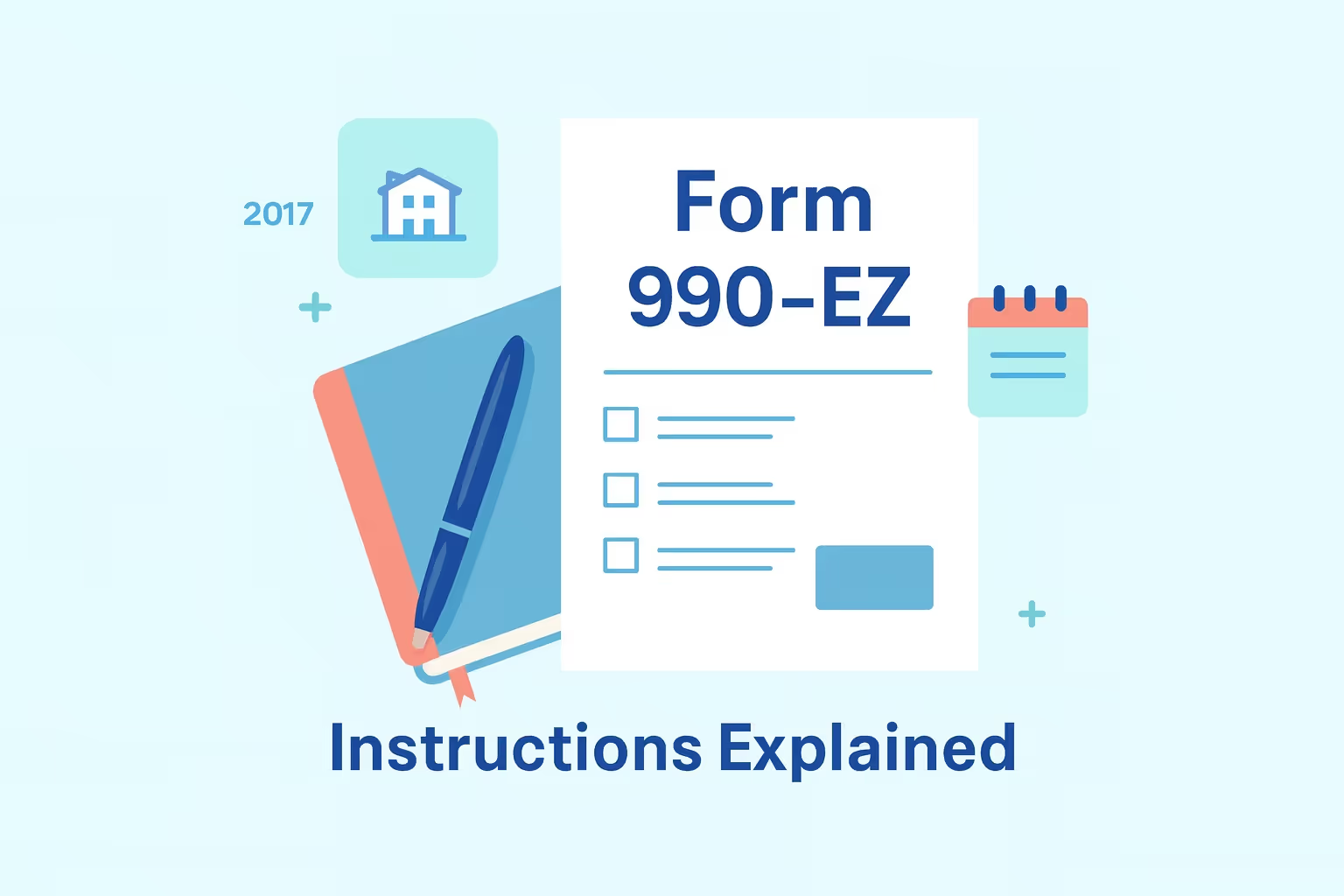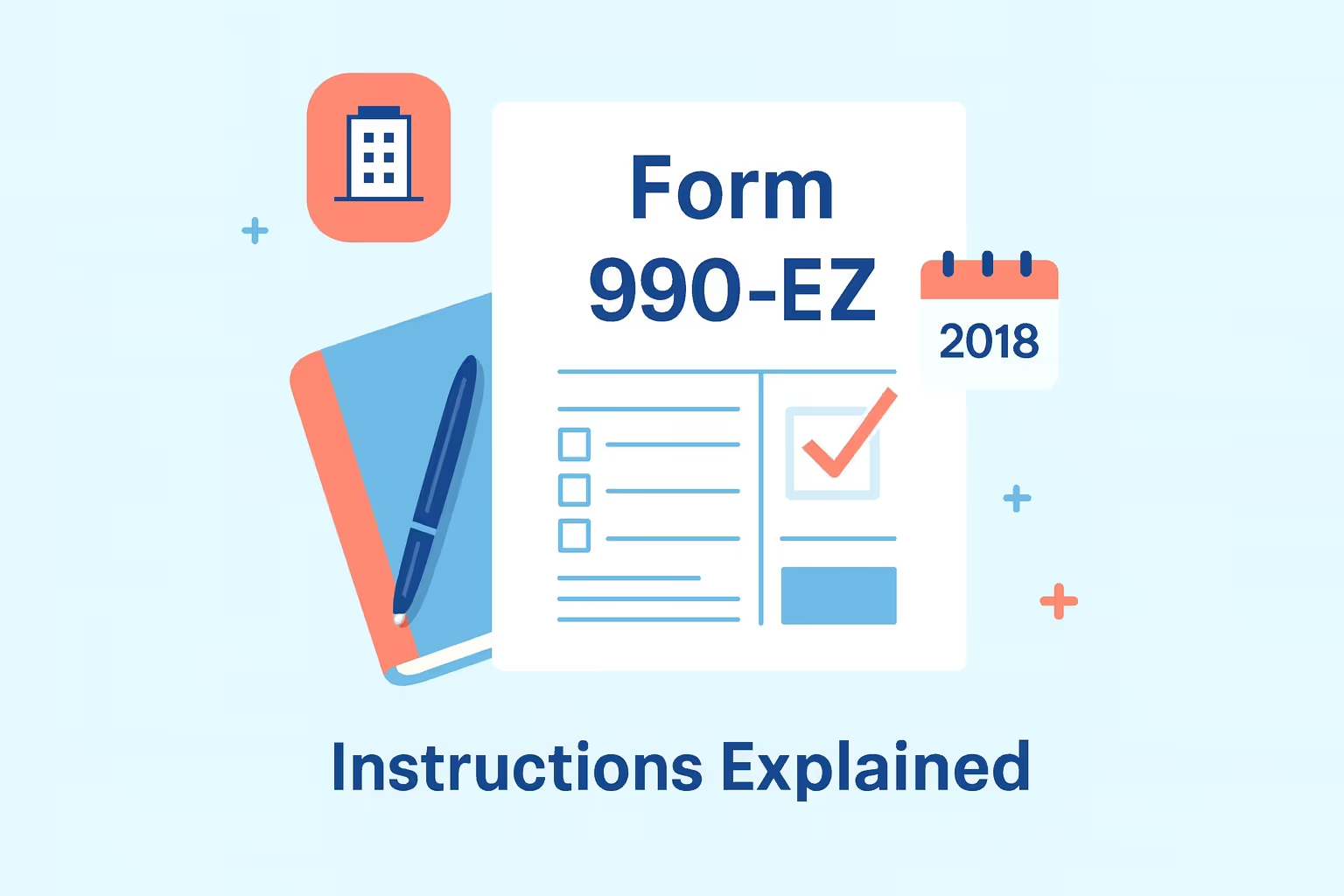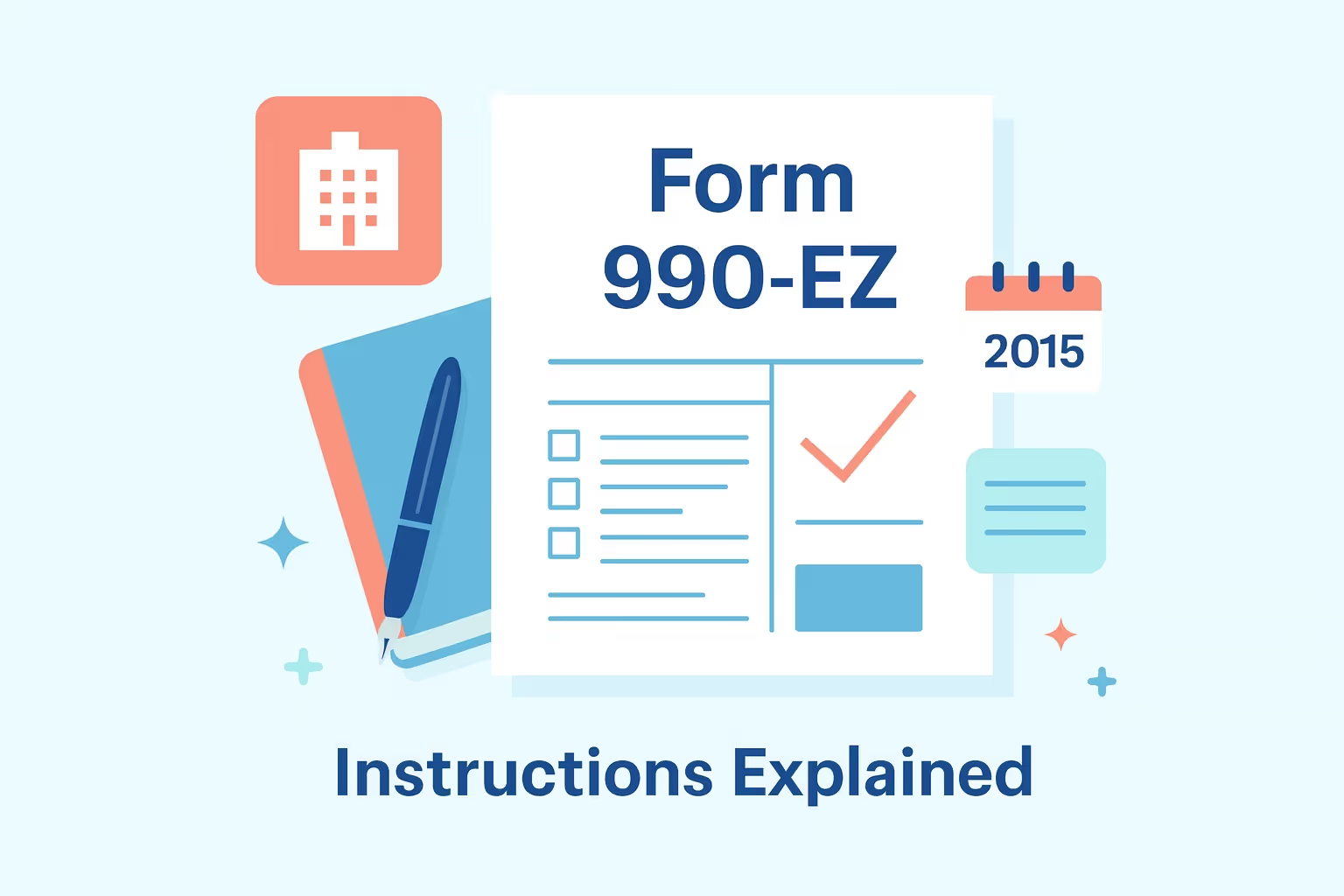Instrucciones del formulario 990-EZ 2016 para la presentación de solicitudes exentas de impuestos para organizaciones sin fines de lucro
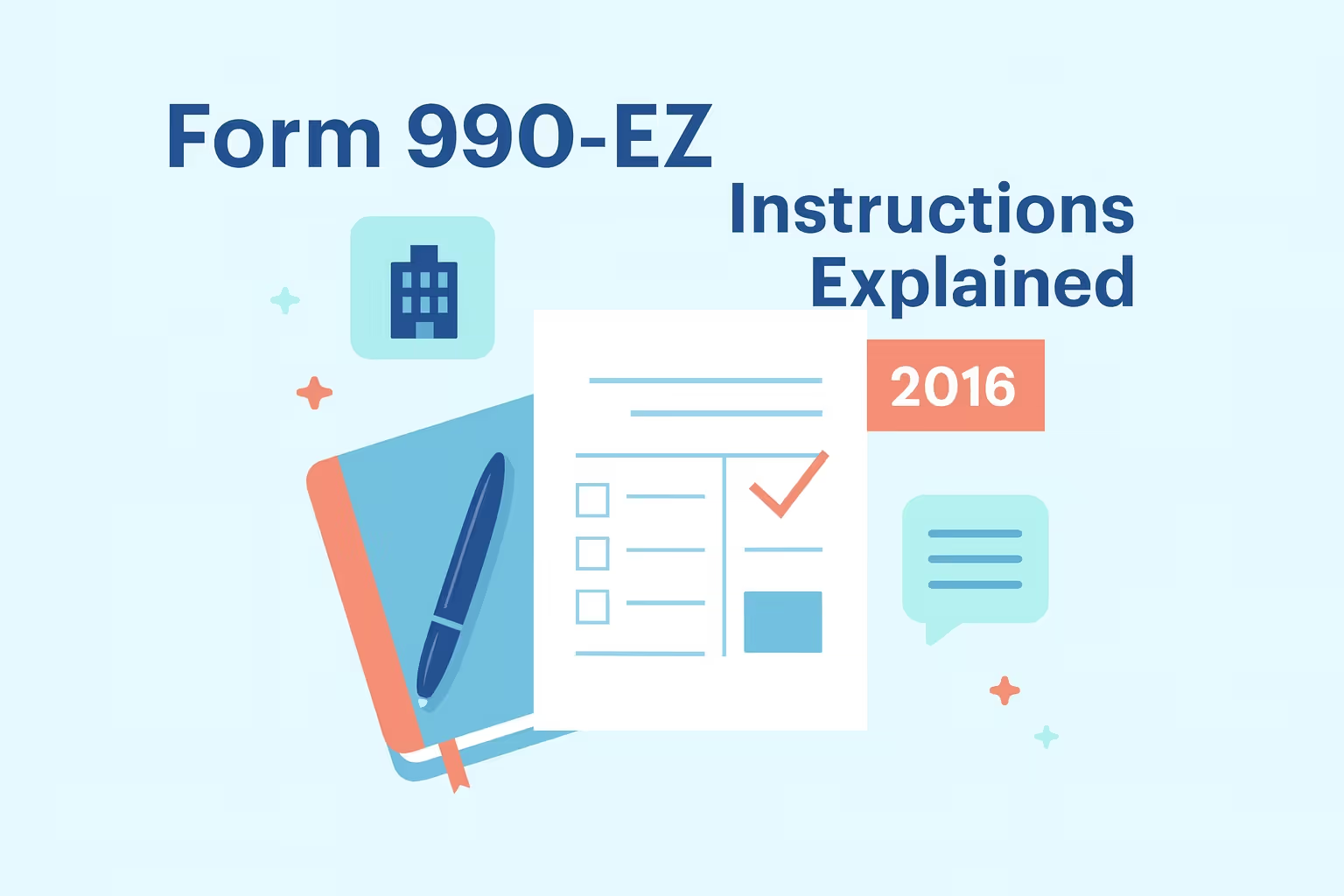
El formulario 990-EZ es una declaración abreviada diseñada para organizaciones sin fines de lucro exentas del impuesto sobre la renta según el Código de Impuestos Internos. Se aplica a grupos con activos totales limitados e ingresos anuales moderados, y proporciona un método simplificado para informar los datos financieros. La presentación de la declaración correcta garantiza que una organización reúna los requisitos para la exención y, al mismo tiempo, rinde cuentas tanto ante las autoridades gubernamentales como ante las comunidades a las que presta servicios.
Para el año tributario 2016, las organizaciones exentas de impuestos, incluidas las organizaciones benéficas, las iglesias y las organizaciones políticas, debían presentar esta declaración si cumplían con criterios específicos. El formulario requiere información sobre los ingresos, las subvenciones recibidas y los recursos utilizados para fines exentos. Si bien estos grupos están exentos del pago del impuesto federal sobre la renta, aún deben presentar una declaración anual para demostrar que cumplen con los requisitos. Proporcionar la información precisa necesaria para la declaración reduce el riesgo de errores y fortalece la confianza del público en las organizaciones sin fines de lucro.
Debido a que muchos líderes se sienten abrumados por estos requisitos, la preparación es esencial. Reunir las cuentas, las notificaciones de exención y los documentos justificativos con antelación ayuda a facilitar la presentación. De acuerdo con el Descripción general del formulario 990 del IRS, revisar las directrices antes de completar la declaración breve facilita la preparación, la revisión y la presentación electrónica o en papel, lo que garantiza que las organizaciones se mantengan al día.
Impuesto sobre la renta y criterios de organización exenta
El formulario 990-EZ proporciona un marco para informar las actividades financieras de las organizaciones sin fines de lucro que están exentas del impuesto sobre la renta. Mientras que las declaraciones de impuestos tradicionales calculan las obligaciones y los pagos, el formulario 990-EZ funciona principalmente para garantizar el cumplimiento de las normas de exención. Refleja la responsabilidad de las organizaciones sin fines de lucro de mantener la transparencia y la rendición de cuentas en virtud del Código de Impuestos Internos, al tiempo que ofrece una opción de presentación de informes basada en el tamaño financiero y la elegibilidad.
En qué se diferencia el formulario 990-EZ de una declaración de impuestos
El formulario 990-EZ tiene un propósito diferente al de una declaración de impuestos estándar. Las organizaciones sin fines de lucro exentas del impuesto sobre la renta según el Código de Impuestos Internos no calculan los ingresos imponibles de la misma manera que las corporaciones o los individuos. En cambio, esta declaración revela las actividades financieras, incluidos los ingresos, las subvenciones y los gastos, para demostrar el cumplimiento de las normas de exención. La presentación también proporciona al público un registro claro de cómo los fondos apoyan las misiones caritativas u organizacionales, lo que contribuye a la transparencia en la rendición de cuentas de las organizaciones sin fines de lucro.
Si bien las declaraciones de impuestos sobre la renta se centran en declarar las ganancias imponibles y determinar los pagos adeudados, el formulario 990-EZ enfatiza la transparencia en la forma en que se administran los recursos. Las organizaciones exentas del impuesto sobre la renta aún deben presentar datos para mantener su buena reputación ante el gobierno. El hecho de no presentar la solicitud puede resultar en la revocación automática del estado de exención, independientemente de si el grupo obtiene ingresos que, de otro modo, estarían sujetos a impuestos. Por esta razón, los líderes deben preparar la información precisa requerida para la declaración breve de cada año.
Definición de una organización exenta según el Código de Rentas Internas
Una organización exenta reúne los requisitos según secciones específicas del Código de Rentas Internas. La sección 501 (c) abarca una variedad de grupos, que incluyen organizaciones benéficas, iglesias, organizaciones políticas y algunas otras entidades sin fines de lucro. Estos grupos reciben una exención del impuesto federal sobre la renta porque operan para fines caritativos, religiosos, educativos o exentos similares, y no para obtener ganancias privadas. La elegibilidad requiere el cumplimiento estricto de los criterios de exención, lo que incluye centrarse en la misión, el mantenimiento de registros y las operaciones legales.
Las organizaciones reconocidas como exentas de impuestos mantienen su exención mediante la presentación de una declaración anual, incluso si no adeudan impuestos. La presentación de informes a través del formulario 990-EZ demuestra el cumplimiento y proporciona datos para que los revisen tanto el Servicio de Impuestos Internos como el público. Por ejemplo, es posible que las iglesias no paguen impuestos sobre la renta sobre los diezmos, pero siguen siendo responsables mediante requisitos de divulgación que salvaguardan la transparencia. Esta estructura permite al gobierno verificar el uso adecuado de los fondos y, al mismo tiempo, permite a los donantes y a las comunidades evaluar la eficacia de la organización.
Límites de elegibilidad para presentar el formulario 990-EZ
Los requisitos de presentación dependen del total de activos y de los ingresos brutos. Para calificar para el formulario 990-EZ para el año tributario 2016, una organización sin fines de lucro debe tener ingresos brutos inferiores a 200 000 dólares y activos totales inferiores a 500 000 dólares al final del año. Los grupos que superen estos límites deben completar el formulario 990 completo, que proporciona informes más detallados. Las organizaciones más pequeñas con recibos que normalmente sean de 50 000$ o menos pueden presentar el formulario 990-N, conocido como tarjeta postal electrónica, siempre que cumplan con los criterios específicos.
El Código de Impuestos Internos establece estos umbrales para hacer coincidir las obligaciones de presentación de informes con la escala financiera de las organizaciones. Al ajustar los requisitos, el gobierno garantiza que las organizaciones sin fines de lucro más grandes proporcionen información más completa, mientras que los grupos más pequeños mantengan la rendición de cuentas con menos complejidad. Cada vía de presentación refleja la capacidad de la organización para preparar y enviar datos, lo que garantiza estándares justos en todo el sector sin fines de lucro.
Quién reúne los requisitos para recibir una postal 990, 990-EZ o 990-N
Las organizaciones sin fines de lucro reúnen los requisitos para una de las tres presentaciones, según los recibos, los activos y las actividades. El formulario 990 se aplica a los grupos con mayores ingresos o activos, así como a los que se identifican específicamente en el Código de Impuestos Internos, como los hospitales o los patrocinadores de fondos asesorados por donantes. El formulario 990-EZ se aplica a las organizaciones exentas del impuesto sobre la renta que se mantienen dentro de los límites de 200 000 y 500 000 dólares. La tarjeta postal 990-N se aplica a las organizaciones más pequeñas, incluidas muchas organizaciones benéficas locales y grupos comunitarios.
La elegibilidad también depende del tipo de organización. Las organizaciones políticas y las iglesias suelen cumplir con los formularios 990-EZ o 990-N, siempre que sus datos financieros cumplan con los requisitos mínimos de presentación. La elección de la declaración refleja el tamaño de la organización y los estándares de rendición de cuentas que garantizan la exención de impuestos. Presentar el formulario correcto garantiza la continuidad del estado de exención y, al mismo tiempo, apoya la rendición de cuentas en las organizaciones sin fines de lucro.
Para cerrar esta sección, el formulario 990-EZ sirve como una herramienta de presentación de informes distinta de una declaración de impuestos convencional. Refleja la responsabilidad de las organizaciones exentas de divulgar información en lugar de calcular los ingresos imponibles. Al aplicar los umbrales de elegibilidad vinculados al total de activos y recibos, el sistema garantiza que las organizaciones exentas de impuestos presenten sus declaraciones con precisión. Los líderes que preparen y revisen sus datos cuidadosamente mantendrán el cumplimiento y fortalecerán la transparencia que se espera de las organizaciones exentas de impuestos federales.
Organización exenta del impuesto sobre la renta
Las organizaciones sin fines de lucro exentas del impuesto sobre la renta aún deben completar las declaraciones anuales. El Código de Impuestos Internos otorga exenciones para fines específicos, pero exige informes consistentes para garantizar la rendición de cuentas. La presentación del formulario 990-EZ demuestra que un grupo continúa destinando fondos a su misión declarada, operando dentro de la ley y preservando su estado de exención.
Por qué las organizaciones exentas de impuestos presentan una solicitud
Incluso cuando no se adeuda ningún impuesto federal sobre la renta, las organizaciones deben declarar los ingresos, los gastos y las actividades del programa. Este informe confirma que las contribuciones, las subvenciones y los recursos promueven el propósito exento. El Servicio de Impuestos Internos utiliza los datos presentados para verificar el cumplimiento, mientras que los donantes y las comunidades a las que apoyan confían en ellos para garantizar la transparencia y la rendición de cuentas. La divulgación anual, por lo tanto, protege tanto la exención como la confianza pública.
Ejemplos de organizaciones elegibles
Los diferentes grupos califican como exentos, siempre que cumplan con los requisitos legales. Las organizaciones benéficas suelen presentar sus solicitudes para demostrar cómo apoyan los programas de ayuda, educación o salud. Las iglesias están exentas del impuesto sobre la renta, pero aun así deben proporcionar los detalles de la organización. Las organizaciones políticas, incluidos los comités locales, presentan sus solicitudes para confirmar el uso legal de las contribuciones. Algunas organizaciones sin fines de lucro vinculadas al gobierno también cumplen con los criterios de exención si sus actividades se alinean con fines públicos.
Función de los avisos de subvenciones y exenciones
Las subvenciones constituyen una parte importante del financiamiento de las organizaciones sin fines de lucro, y reportar su uso demuestra integridad financiera. Las organizaciones deben contabilizar los fondos otorgados por agencias gubernamentales o fundaciones privadas para establecer la aplicación adecuada de estos fondos a los objetivos de su misión. Los avisos de exención emitidos por el Servicio de Impuestos Internos confirman además la elegibilidad y deben mantenerse como parte de un registro preciso. Hacer referencia a estos documentos durante las presentaciones anuales respalda la confiabilidad de los datos enviados.
Al completar estos requisitos, las organizaciones exentas mantienen la responsabilidad y refuerzan su elegibilidad. La presentación transparente de informes sobre las subvenciones, los recursos y las notificaciones de exención garantiza que sigan prestando servicios al público de manera eficaz y, al mismo tiempo, cumpliendo con el Código de Impuestos Internos.
Proveedor autorizado de archivos electrónicos y presentación electrónica
Las organizaciones sin fines de lucro que reúnen los requisitos para la exención del impuesto sobre la renta suelen utilizar la presentación electrónica para presentar el formulario 990-EZ. Este proceso requiere el uso de un proveedor de archivos electrónicos autorizado por el IRS, para garantizar que los datos permanezcan seguros y se transmitan con precisión. Comprender cómo funcionan estos proveedores y cómo se compara la presentación electrónica con los métodos tradicionales en papel ayuda a las organizaciones a prepararse para presentar presentaciones eficientes y conformes con las normas.
- Proveedor de archivos electrónicos autorizado por el IRS
Un proveedor de archivos electrónicos autorizado por el IRS es una persona o empresa aprobada para transmitir declaraciones en nombre de organizaciones sin fines de lucro. La autorización requiere pasar las comprobaciones de idoneidad y cumplir con los estándares técnicos para garantizar la seguridad de las transmisiones.
Estos proveedores son monitoreados de cerca para garantizar el cumplimiento de los requisitos federales, garantizando que los datos confidenciales de las organizaciones exentas de impuestos permanezcan protegidos. Trabajar con proveedores aprobados garantiza que las presentaciones cumplan con las normas y reglamentos técnicos gubernamentales.
- Presentación electrónica frente a archivadores en papel
La presentación electrónica proporciona eficiencia y precisión, mientras que la presentación en papel sigue siendo una opción para las organizaciones con acceso limitado a Internet. Para organizaciones sin fines de lucro. Los declarantes reciben una confirmación instantánea de su recepción y el sistema detecta automáticamente los errores antes de enviarlos.
Los declarantes en papel suelen experimentar tiempos de procesamiento más prolongados, posibles retrasos en el envío y un mayor riesgo de perder los documentos. Si bien la presentación en papel sigue estando disponible para quienes tienen acceso limitado a Internet, la presentación electrónica ofrece claras ventajas en términos de velocidad y confiabilidad.
- Acceso a Internet, requisitos del sistema y Adobe Acrobat Reader
La presentación electrónica exitosa requiere un acceso confiable a Internet y el cumplimiento de los requisitos del sistema. Los proveedores autorizados especifican navegadores, protocolos de seguridad y firewalls compatibles para garantizar una transmisión fluida. Como los formularios del IRS suelen ser archivos PDF que se pueden rellenar, muchas organizaciones utilizan Adobe Acrobat Reader para completar, preparar y revisar sus declaraciones. El software actualizado evita los errores de formato y mantiene una presentación uniforme de los datos. - Beneficios de las declaraciones presentadas electrónicamente
Las organizaciones sin fines de lucro obtienen múltiples ventajas al presentar sus declaraciones electrónicamente. El procesamiento suele ser más rápido, lo que ayuda a confirmar el cumplimiento y a reducir el trabajo administrativo. Las funciones de validación integradas reducen los errores y mejoran la precisión de los ingresos, las subvenciones y los gastos declarados.
Los recibos de confirmación también sirven como prueba oficial de envío, mientras que la transmisión cifrada de datos protege los avisos de exención, las cuentas y los registros financieros. La presentación electrónica se alinea tanto con la eficiencia operativa como con la administración responsable de los recursos de las organizaciones sin fines de lucro.
La presentación electrónica a través de proveedores autorizados por el IRS se ha convertido en una herramienta esencial para las organizaciones sin fines de lucro. Al cumplir con los requisitos de seguridad del sistema y adoptar procesos digitales, los líderes mantienen la transparencia y, al mismo tiempo, protegen el estado de exención. Como se describe en el Instrucciones para el formulario 990-EZ del IRS, la presentación electrónica de las declaraciones proporciona precisión y eficiencia, lo que refuerza la confianza del público en la presentación de informes de las organizaciones sin fines de lucro.
Tutorial de devolución de formularios cortos
El formulario 990-EZ a menudo se denomina declaración abreviada porque requiere menos detalles que el formulario 990 completo y, al mismo tiempo, cumple con los requisitos del Servicio de Impuestos Internos. Las organizaciones sin fines de lucro lo utilizan para informar sobre las actividades financieras, la información de gobierno y los logros de los servicios del programa cuando sus ingresos brutos y activos totales están por debajo de los umbrales establecidos. Este tutorial proporciona una guía estructurada para preparar, revisar y enviar el formulario 990-EZ, a fin de garantizar que las organizaciones exentas cumplan con los requisitos federales.
Paso 1: Reunir información clave
Antes de comenzar el formulario, las organizaciones deben recopilar todos los datos requeridos. Esto incluye los estados financieros, las cuentas bancarias, los registros de subvenciones, las cartas de exención y los detalles de los funcionarios o directores. Tener estos recursos listos reduce el riesgo de errores y agiliza el proceso de preparación. Los registros de respaldo precisos también simplificarán la revisión si surgen preguntas más adelante.
Paso 2: Complete la sección de encabezado
El encabezado proporciona detalles de identificación, como el nombre, la dirección, el número de identificación del empleador y el estado de exención de la organización según el Código de Impuestos Internos. Los grupos deben indicar su método de contabilidad, si utilizan un año calendario o fiscal y cualquier cambio en las operaciones. Las organizaciones que hayan presentado anteriormente otros formularios, incluida la tarjeta postal 990-N o que hayan completado el formulario 990, deben marcar la casilla «Declaración inicial» o «Declaración enmendada», cuando corresponda. Esta sección establece la base para el resto de la presentación.
Paso 3: Reportar ingresos y gastos
La Parte I exige que las organizaciones ingresen las contribuciones, los ingresos por servicios del programa, las cuotas de membresía y las subvenciones. Las categorías de gastos incluyen la compensación, los servicios profesionales, los costos de ocupación y otros pagos operativos. Cada línea debe alinearse con las cuentas financieras y los datos de respaldo para garantizar la precisión. La presentación de informes adecuada refleja la forma en que las organizaciones exentas de impuestos administran sus recursos.
Paso 4: Complete el balance
La parte II detalla los activos, pasivos y activos netos. Las organizaciones registran el efectivo, los ahorros, las inversiones, los edificios y otras propiedades. También se incluyen los pasivos, como las deudas y las cuentas por pagar, y los activos netos se calculan como la diferencia entre los totales. Equilibrar estas entradas con las cifras del año anterior garantiza la coherencia y refuerza el cumplimiento de los requisitos de exención.
Paso 5: Describa los logros del servicio del programa
La Parte III permite a las organizaciones resaltar su propósito exento a través de las actividades del programa. Cada iniciativa importante debe describirse con claridad, y los gastos declarados deben estar vinculados a los servicios y programas impulsados por la misión. Las subvenciones, los programas educativos o las distribuciones caritativas deben explicarse de manera que sean coherentes con el propósito declarado de la organización. Esta sección proporciona al público un registro claro de cómo las organizaciones sin fines de lucro cumplen sus misiones.
Paso 6: Identificar a los funcionarios y empleados clave
La Parte IV exige la divulgación de los funcionarios, directores y empleados con responsabilidades importantes. Cada entrada debe incluir el promedio de horas semanales, la compensación y cualquier beneficio adicional. Los informes precisos promueven la transparencia y fortalecen la confianza en la gobernanza de las organizaciones sin fines de lucro.
Paso 7: Abordar la información y los horarios adicionales
La Parte V cubre una serie de preguntas de cumplimiento sobre ingresos comerciales no relacionados, actividades políticas y cambios operativos. Si una respuesta requiere más detalles, el declarante debe usar el Anexo O para proporcionar explicaciones. Adjuntar los anexos requeridos y hacer referencia a los avisos de exención garantiza que todos los detalles cumplan con los estándares gubernamentales de presentación de solicitudes.
Paso 8: Revisar y enviar
El último paso consiste en revisar todas las entradas para comprobar su precisión antes de enviarlas. Las organizaciones sin fines de lucro deben confirmar que los totales coinciden en todas las partes, que se incluyen todos los cronogramas y que un oficial autorizado completa la firma. Una vez revisada, la declaración puede presentarse electrónicamente a través de un proveedor autorizado o enviarse por correo si es necesario presentarla en papel.
El formulario 990-EZ simplifica la presentación de informes para las organizaciones más pequeñas, pero aun así requiere una preparación minuciosa y atención a los detalles. Al seguir cada paso, las organizaciones sin fines de lucro se aseguran de que sus cuentas, datos e información sobre exenciones se publiquen con precisión. Este enfoque estructurado ayuda a las organizaciones a cumplir con las normas y, al mismo tiempo, refuerza la transparencia que se espera de las personas exentas del impuesto federal sobre la renta.
Organizaciones sin fines de lucro y guía de presentación
Las organizaciones sin fines de lucro deben seguir un enfoque estructurado al preparar el formulario 990-EZ. La presentación correcta protege la exención del impuesto sobre la renta y, al mismo tiempo, garantiza el cumplimiento del Código de Impuestos Internos. Cada tipo de organización tiene requisitos únicos, por lo que la preparación implica más que llenar formularios: requiere un registro minucioso, informes precisos y una presentación puntual.
Proceso de presentación y preparación de registros
El proceso de presentación comienza con la recopilación de la información financiera esencial. Las organizaciones sin fines de lucro deben revisar los informes de ingresos, los estados de gastos y los saldos de las cuentas antes de completar el breve formulario de declaración. Las iglesias y las organizaciones políticas pueden tener requisitos adicionales, en particular cuando reportan contribuciones o actividades de cabildeo. Una preparación cuidadosa garantiza que cada línea del formulario 990-EZ refleje datos confiables.
- Organizaciones caritativas
Las organizaciones benéficas declaran las donaciones, las subvenciones y los ingresos relacionados con los programas para garantizar que los gastos se ajusten a su misión exenta. La divulgación adecuada refuerza la confianza en la forma en que los recursos apoyan los programas comunitarios. - Iglesias y organizaciones religiosas
Las iglesias proporcionan detalles sobre el liderazgo, la gobernanza y el uso de las contribuciones. Sus informes confirman que los fondos se administran de manera responsable y de acuerdo con las normas de exención.
Información adicional para organizaciones políticas
Las organizaciones políticas se enfrentan a distintos requisitos de divulgación. Deben declarar las contribuciones recibidas, los gastos realizados y las actividades que demuestren el uso legal de los recursos. Estos detalles protegen la transparencia y evitan el uso indebido de los privilegios exentos de impuestos. El formulario 990-EZ proporciona al gobierno y al público una visión clara de cómo funcionan estas organizaciones dentro de los límites de la ley.
- Registros de organizaciones políticas
Los informes de las organizaciones políticas deben incluir los gastos de la campaña, la actividad de recaudación de fondos y los pagos a contratistas o consultores. Esta información respalda el cumplimiento de los requisitos federales. - Registros financieros de todos los declarantes
Cada declarante debe conciliar las cuentas, confirmar los totales declarados y asegurarse de que la documentación de respaldo coincida con la información presentada en la declaración. Los procesos de revisión interna de cada organización reducen los errores y ayudan a mantener la exención.
Sistemas de precisión y cumplimiento
Un sistema fiable garantiza la precisión durante todo el año. Las organizaciones sin fines de lucro se benefician de las revisiones mensuales de las cuentas, de la supervisión por parte de las juntas o comités de finanzas y de un software de contabilidad seguro. Los borradores deben someterse a controles exhaustivos antes de su presentación para confirmar que se incluyen todos los cronogramas y que los totales se alinean en todas las secciones.
La guía de presentación de solicitudes para organizaciones sin fines de lucro demuestra que la preparación precisa es fundamental para el cumplimiento. Al revisar cuidadosamente los registros y divulgar la información requerida, cada grupo mantiene la transparencia y la responsabilidad. Los sistemas sólidos y los informes confiables refuerzan tanto el estado de exención como la confianza pública que respalda las misiones de las organizaciones sin fines de lucro.
Cronogramas y anexos requeridos
Las organizaciones sin fines de lucro que presentan el formulario 990-EZ a menudo deben incluir anexos adicionales para proporcionar información detallada. Estos archivos adjuntos documentan a los contribuyentes, las actividades políticas y otra información requerida por el Código de Impuestos Internos. Los cronogramas faltantes o incompletos son problemas frecuentes que retrasan la aceptación o afectan el cumplimiento de las exenciones.
Información requerida en los horarios
- Anexo A: Estatus de organización benéfica pública y apoyo público: Este cronograma es obligatorio para que las organizaciones de la sección 501 (c) (3) documenten las pruebas de apoyo y las fuentes de financiamiento público.
- Programa B — Calendario de colaboradores: En este cronograma se enumeran los donantes que contribuyen con 5000 dólares o más, o aquellos cuyas donaciones superan el 2 por ciento del total de las contribuciones.
- Anexo C — Actividades políticas y cabildeo: Este cronograma es presentado por organizaciones que participan en actividades de cabildeo o relacionadas con campañas para divulgar los gastos y las actividades.
- Anexo O — Información complementaria: Este programa proporciona explicaciones ampliadas para respuestas complejas o circunstancias únicas que no caben en el formulario principal.
Brechas comunes y archivos adjuntos faltantes
- Programa A incompleto: Cuando las organizaciones cometen errores al calcular el apoyo público u omiten las partes requeridas, la presentación puede requerir una revisión adicional.
- Anexo B omitido: Cuando las organizaciones sin fines de lucro no incluyen la información requerida sobre los contribuyentes, plantean problemas de cumplimiento.
- Faltan informes de actividad política: Las organizaciones con actividades de cabildeo o de campaña deben completar el Anexo C, pero muchas pasan por alto este requisito.
- Falta de explicaciones complementarias: Cuando las organizaciones no incluyen el Anexo O, donde se requieren detalles adicionales, sus informes se vuelven insuficientes.
Preparación y organización de los cronogramas para las fechas límite de abril
- Reúna los datos de forma temprana: Las organizaciones deben recopilar información sobre los contribuyentes, las subvenciones y las actividades antes del período de presentación de abril.
- Utilice un mantenimiento de registros coherente: Las organizaciones deben mantener registros durante todo el año de los donantes, los gastos políticos y las decisiones de la junta para obtener informes precisos.
- Ordene los archivos adjuntos correctamente: Las organizaciones deben presentar los cronogramas en el orden requerido para que la presentación permanezca completa y lista para su revisión.
- Revisión antes del envío: Las organizaciones deben verificar todos los cronogramas comparándolos con la declaración para asegurarse de que no haya brechas ni cifras desalineadas.
Los cronogramas bien preparados respaldan la presentación precisa de informes sin fines de lucro y el cumplimiento fluido de los requisitos de presentación. Al organizar los archivos adjuntos antes de las fechas límite de abril, las organizaciones reducen el riesgo de errores y garantizan la transparencia.
Errores comunes y proceso de revisión
La presentación del formulario 990-EZ requiere precisión, pero muchas organizaciones sin fines de lucro encuentran errores que retrasan el procesamiento o crean problemas de cumplimiento. A menudo se producen errores al informar los detalles de identificación básicos, el estado de exención o el total de los activos. Estos descuidos pueden parecer menores, pero afectan la precisión y la credibilidad de la presentación y aumentan el riesgo de que el Servicio de Impuestos Internos envíe correspondencia.
- Número de identificación del empleador (EIN) incorrecto: Los declarantes a veces introducen EIN desactualizados o incorrectos, y estos errores pueden provocar el rechazo de los envíos.
- Activos totales mal declarados: Cuando se producen discrepancias entre los balances y las cuentas de respaldo, crean inconsistencias en los informes.
- Faltan detalles del aviso de exención: Cuando las organizaciones no hacen referencia al estado de exención ni adjuntan el aviso correspondiente, la validez de la declaración se debilita.
También se producen errores en la entrada de datos al conciliar los ingresos y los gastos. Al declarar de manera incorrecta las contribuciones de los donantes, los fondos de las subvenciones o los gastos del programa, los totales no coinciden en todo el formulario. Estos errores retrasan el proceso de revisión y resaltan las brechas en el mantenimiento de registros.
- Totales de cuentas inexactos: Cuando las cuentas bancarias no se concilian o los libros de contabilidad no coinciden, surgen discrepancias en los informes.
- Información complementaria omitida: Cuando las organizaciones no incluyen las explicaciones del Anexo O cuando es necesario, la presentación queda incompleta.
Un proceso de revisión exhaustivo mejora el cumplimiento y garantiza la precisión antes de la presentación. Las organizaciones deben conciliar las cuentas, confirmar que el EIN y los detalles de la exención coinciden con los avisos oficiales y verificar que las cronogramas estén completas. Al implementar estas estrategias, las organizaciones sin fines de lucro demuestran diligencia en la presentación de informes y, al mismo tiempo, protegen su estado de exención.
Declaraciones presentadas electrónicamente y requisitos del sistema
Las organizaciones sin fines de lucro confían cada vez más en las declaraciones presentadas electrónicamente para completar sus presentaciones anuales de manera segura y eficiente. La presentación electrónica reduce los errores, proporciona un procesamiento más rápido y crea registros de confirmación que sirven como prueba de cumplimiento. Para aprovechar este sistema, las organizaciones deben cumplir con los requisitos técnicos que garantizan una transmisión de datos precisa y protegen los detalles confidenciales de la exención.
La presentación electrónica requiere un acceso estable a Internet y una tecnología compatible. Los proveedores autorizados de archivos electrónicos describen las especificaciones del sistema, incluidos los navegadores aprobados, los protocolos de cifrado y la configuración del firewall. Muchos formularios, incluido el formulario 990-EZ, utilizan archivos PDF rellenables, que requieren un software actualizado, como Adobe Acrobat Reader, para formatearlos correctamente. El cumplimiento de estos requisitos técnicos reduce el riesgo de devoluciones rechazadas o de retrasos en el procesamiento.
Los beneficios de las declaraciones presentadas electrónicamente van más allá de la velocidad. Las comprobaciones de errores integradas identifican los datos faltantes o los totales inconsistentes antes de la presentación, lo que permite a las organizaciones corregir los problemas de inmediato. Los recibos generados después de la transmisión confirman que el Servicio de Impuestos Internos ha aceptado la declaración. Al adoptar sistemas de archivo electrónico seguros, las organizaciones sin fines de lucro refuerzan el cumplimiento y, al mismo tiempo, protegen los registros financieros, las divulgaciones de subvenciones y el estado de exención en virtud del Código de Impuestos Internos.
Preguntas frecuentes
¿Cuál es el propósito del formulario 990-EZ para las organizaciones sin fines de lucro?
El formulario 990-EZ es la declaración abreviada que utilizan las organizaciones sin fines de lucro con ingresos brutos y activos totales limitados. Se diferencia de una declaración de impuestos sobre la renta porque las organizaciones exentas no calculan la obligación tributaria. En cambio, divulgan datos sobre ingresos, gastos y subvenciones para mantener la exención en virtud del Código de Impuestos Internos. La presentación garantiza la transparencia y el cumplimiento, lo que permite a las organizaciones exentas del impuesto sobre la renta seguir operando de acuerdo con las normas federales.
¿Cuál es la fecha límite para presentar el formulario 990-EZ para el año tributario 2016?
La fecha límite de presentación es el día 15 del quinto mes después del cierre del período contable. Para los declarantes del año calendario, esta fecha fue el 15 de mayo de 2017. Las organizaciones del año fiscal calculan la fecha límite en función de su cierre de año. La presentación oportuna demuestra su responsabilidad y ayuda a las organizaciones exentas de impuestos a cumplir con las regulaciones federales, manteniendo así su estado de exención en virtud de la sección correspondiente del Código de Impuestos Internos.
¿Pueden las organizaciones sin fines de lucro solicitar una prórroga para presentar sus declaraciones de impuestos?
Sí, las organizaciones sin fines de lucro pueden solicitar tiempo adicional enviando el formulario 8868 antes de la fecha límite original. Esta solicitud otorga una prórroga de seis meses para presentar la solicitud, pero no amplía el plazo para pagar el impuesto sobre la renta empresarial no relacionado con el formulario 990-T. Al utilizar un proveedor autorizado de archivos electrónicos, las organizaciones garantizan la presentación electrónica segura de las solicitudes de prórroga, preservan el estado de exención y mantienen registros precisos para su divulgación pública.
¿Quién reúne los requisitos para presentar el formulario 990-EZ en lugar del formulario 990?
Las organizaciones pueden presentar el formulario 990-EZ si sus ingresos brutos son inferiores a 200 000$ y sus activos totales son inferiores a 500 000$ al final del año. Las organizaciones sin fines de lucro, incluidas las organizaciones benéficas, las organizaciones políticas y determinadas iglesias, reúnen los requisitos cuando cumplen con estos requisitos. Las organizaciones más grandes deben presentar el formulario 990 completo, mientras que los grupos más pequeños con recibos de normalmente 50 000 dólares o menos pueden enviar la postal 990-N de forma electrónica. Estos criterios garantizan el cumplimiento y reflejan la capacidad de la organización para cumplir sus objetivos.
¿Cuáles son los beneficios de las declaraciones presentadas electrónicamente para las organizaciones sin fines de lucro?
Las declaraciones presentadas electrónicamente ofrecen un procesamiento más rápido, menos errores y una mayor seguridad de los datos en comparación con las declaraciones en papel. Las organizaciones sin fines de lucro se benefician de los controles integrados que marcan la información faltante antes de enviarla. Para garantizar el cumplimiento, se requiere acceso a Internet y software actualizado, como Adobe Acrobat Reader. El uso de un proveedor de archivos electrónicos autorizado por el IRS permite a las organizaciones sin fines de lucro transmitir registros precisos de forma segura, mantener el estado de exención y cumplir con los estándares de responsabilidad para los donantes y las agencias gubernamentales.
















